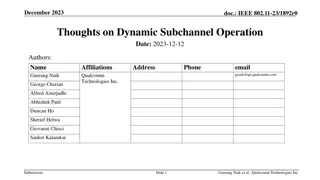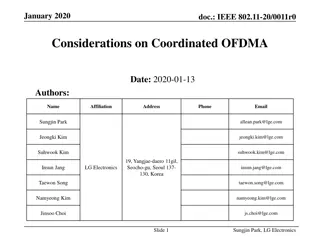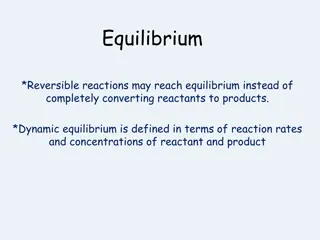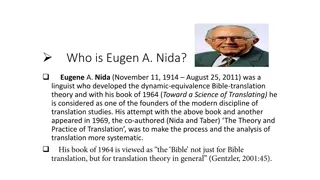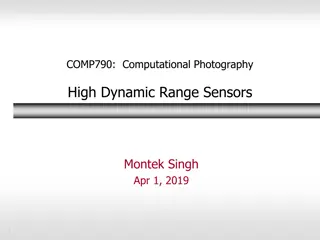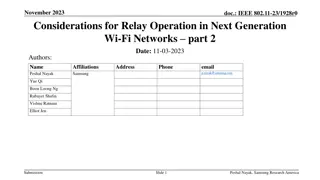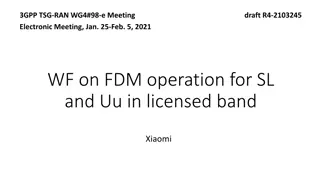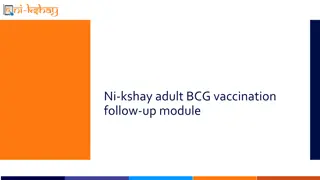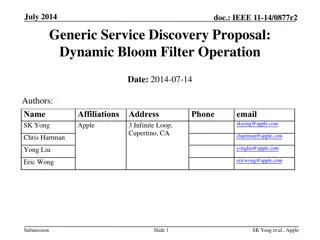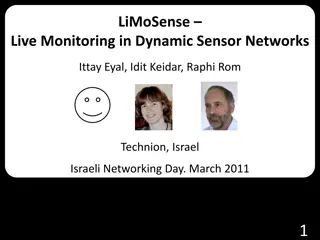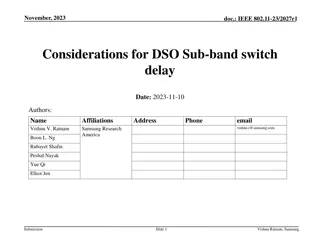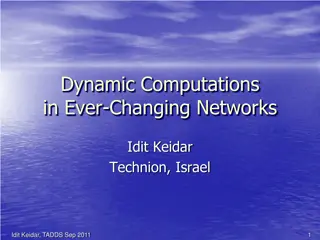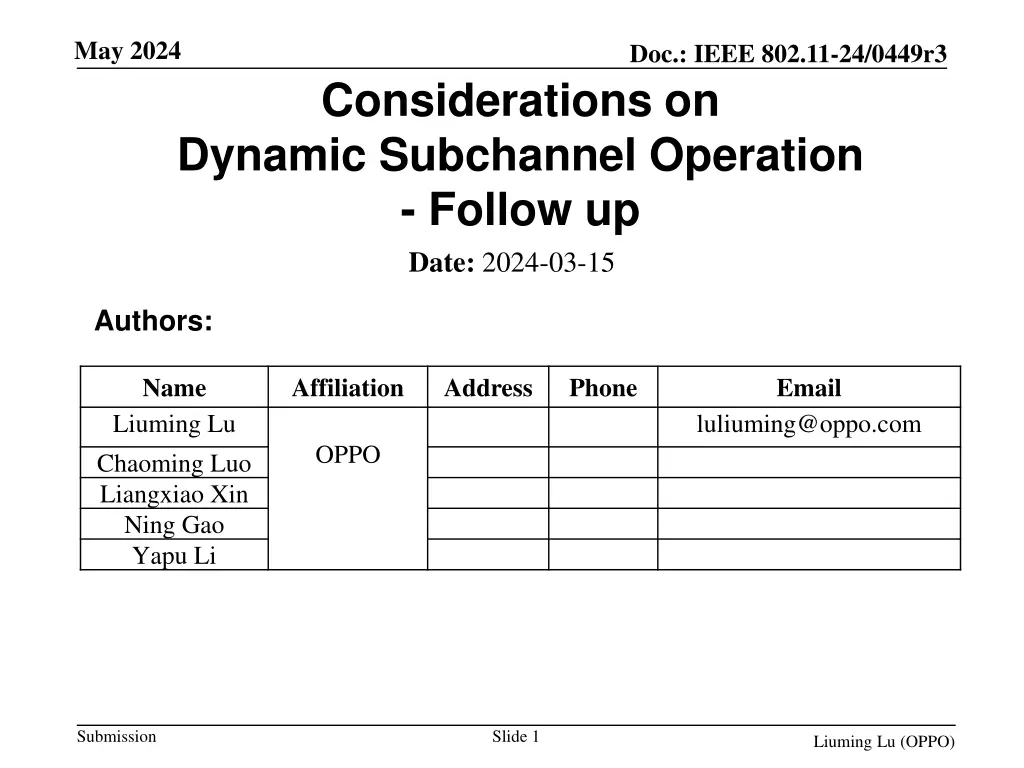
Dynamic Subchannel Operation in IEEE 802.11-24: Considerations & Benefits
Explore the dynamic subchannel operation (DSO) in IEEE 802.11-24 for enhanced WLAN reliability. Learn about the key functions, suitable scenarios, and the flexible management of DSO mode to improve medium efficiency compared to IEEE P802. Discover the benefits of DSO based on channel bandwidth, conditions, QoS, and power-saving requirements for APs and non-AP STAs.
Download Presentation

Please find below an Image/Link to download the presentation.
The content on the website is provided AS IS for your information and personal use only. It may not be sold, licensed, or shared on other websites without obtaining consent from the author. If you encounter any issues during the download, it is possible that the publisher has removed the file from their server.
You are allowed to download the files provided on this website for personal or commercial use, subject to the condition that they are used lawfully. All files are the property of their respective owners.
The content on the website is provided AS IS for your information and personal use only. It may not be sold, licensed, or shared on other websites without obtaining consent from the author.
E N D
Presentation Transcript
May 2024 Doc.: IEEE 802.11-24/0449r3 Considerations on Dynamic Subchannel Operation - Follow up Date: 2024-03-15 Authors: Name Liuming Lu Chaoming Luo Liangxiao Xin Ning Gao Yapu Li Affiliation Address Phone Email luliuming@oppo.com OPPO Submission Slide 1 Liuming Lu (OPPO)
May 2024 Doc.: IEEE 802.11-24/0449r3 Introduction UHR takes efficient use of the medium for enhancement of WLAN reliability as a main Objective at least one mode of operation capable of improving efficient use of the medium compared to IEEE P802.11be.[1] Dynamic Subchannel Operation (DSO) that allows a 20MHz non-AP STA to be allocated resource on the secondary 20MHz channel that is outside of the STA s operating bandwidth has been prosposed by members [2,3] In the TGbn May 2024 meeting, Non-Primary Channel Access (NPCA) has been consent to be added to TGbn SFD, and members had some concerns on DSO during the discussion.[4,5] This contribution further analyzes the suitable scenarios for DSO and proposes a mechanism for the flexible management of DSO mode in UHR. Submission Slide 2 Liuming Lu (OPPO)
May 2024 Doc.: IEEE 802.11-24/0449r3 DSO & NPCA Key function Suitable scenarios 1. OBSS scenarios AP and STA(s) suffer from the same OBSS interference (e.g. from the same OBSS, and RSSI from OBSS interference is relatively high), which makes the AP and STA(s) switch to the anchor channel simultaneously NPCA enables a STA to access the secondary channel while the primary channel is known to be busy due to OBSS traffic or other TBD conditions.[4] 1. non-OBSS scenarios AP that gain a TXOP for large BW can allocate different frequency resources to several STAs, among which at least one STA(s) is allocated resource outside of its current operating bandwidth. 2. OBSS scenarios Both or one of AP and STA(s) suffer from the OBSS interference but RSSI for OBSS interference is relatively low(e.g. the condition for SR is satisfied) 3. IDC scenarios a non-AP STA can be allocated channel(s) outside of its current operating bandwidth with better channel condition. DSO a non-AP STA can be allocated resources dynamically (i.e., on a per-TXOP basis) outside of its current operating bandwidth and within the associated AP s BSS bandwidth.[5] (TBD.) Submission Slide 3 Liuming Lu (OPPO)
May 2024 Doc.: IEEE 802.11-24/0449r3 DSO as a mode of operation The benefit from DSO depends on what channel bandwidth AP can gains, the channel conditions (such as IDC issue, OBSS interference) and requirements of QoS and power save for the AP and non-AP STAs. Enable or disabling DSO mode can be a good tool for the flexible management of DSO. STAs may disable DSO mode based on the following conditions : The channel(s) outside of STAs operating channel but within their associated BSS bandwidth is unavailable for the STAs, such as the channels are occupied by other wireless technologies, such as Bluetooth, The channel(s) outside of STAs operating channel but within their associated BSS bandwidth are interfered by OBSS transmissions. Submission Slide 4 Liuming Lu (OPPO)
May 2024 Doc.: IEEE 802.11-24/0449r3 DSO as a mode of operation (Cont.) DSO-capable non-AP STAs can enable or disable the DSO mode when it is associated with DSO-capable AP Enabling the DSO mode, the STA can operate on its current operating channel(s) when no DSO initial control frame (ICF) addressed to it is received do frame exchanges on its DSO channel(s) followed by an DSO ICF addressed to it from its associated AP. wherein the DSO channel(s) can be outside of the STA s current operating channel(s) but within the operating channel(s) of its associated AP with which the STA is associated. Disabling the DSO mode, the STA always operate on the current operating channel Submission Slide 5 Liuming Lu (OPPO)
May 2024 Doc.: IEEE 802.11-24/0449r3 DSO as a mode of operation (Cont.) Signaling for DSO Enabling DSO mode: An DSO-capable non-AP STA can enable dynamically DSO mode by notifying the DSO-capable AP or by negotiating with the DSO-capable AP. DSO operation parameters, such as DSO mode indication enabling DSO mode , DSO channel, DSO maximum operating bandwidth ,DSO padding delay, is carried in the DSO mode exchange frames (such as DSO mode notification frame). Frame exchanges in DSO mode: When obtaining a TXOP on the DSO channel, the DSO-capable AP allocates individually addressed RUs addressed to the DSO-capable non-AP STA that are within the DSO channel indicated in the DSO mode notification frame or DSO mode response frame by sending DSO initial control frame the DSO-capable non-AP STA switch to the DSO channel when receiving DSO initial control frame addressed to it, and than exchange frames with the AP, and switch back to the operating channel after the end of the frame exchanges. Updating parameter(s) in DSO mode. An DSO-capable non-AP STA in DSO mode can update dynamically current operating channel and/or DSO parameters by sending a DSO mode notification frame with DSO mode indication (enabling DSO mode) and DSO parameters to be updated to the DSO-capable AP . AP responds to the DSO mode notification frame Disabling DSO mode An DSO-capable non-AP STA can disable DSO mode by sending a DSO mode notification frame with DSO mode indication (disabling DSO mode) to the DSO-capable AP. Submission Slide 6 Liuming Lu (OPPO)
May 2024 Doc.: IEEE 802.11-24/0449r3 Example for disabling/enabling DSO mode Non-AP STA can disable/enable DSO mode depending on their QoS requirements and channel conditions. At the beginning STA2 disables the DSO mode as the channel condition for the DSO channel is not well, such as OBSS interference suffered. STA2 enables the DSO mode by sending DSO mode notification frame after some time as the channel condition for the DSO channel becomes well AP responds to the DSO mode notification frame by sending another DSO notification frame, which causes STA2 to enter into DSO mode. DSO padding delay DSO switch delay SIFS SIFS SIFS channel Primary 20 MHz DSO mode notification frame DSO initial control frame channel Primary 40 MHz AP channel Primary 20 MHz Repsonse frame channel 40 MHz DL/UL OFDMA Primary 40 MHz Non-AP STA1 DSO mode indication enabling DSO mode DSO channel, DSO maximum operating bandwidth , DSO padding delay , channel Primary 20 MHz DSO mode notification frame channel Primary 40 MHz Non-AP STA2 Response frame Switch back to the operating channel Non-AP STA2 that is not operating in DSO mode Non-AP STA2 operating in DSO mode Submission Slide 7 Liuming Lu (OPPO)
May 2024 Doc.: IEEE 802.11-24/0449r3 Example for updating operating parameters Non-AP STA can update the operating parameters in DSO mode depending on their requirement for QoS and power save. At the beginning the STA communicates with the AP through primary 40MHz channel The STA enables the DSO mode for updating the operating parameters(such as DSO channels etc.) by sending DSO mode notification frame based on the power save requirement. AP responds to the DSO mode notification frame by sending another DSO notification frame, which causes the STA to enter into DSO mode. The operating parameters: primary 20MHz channel (the maximum bandwidth is 20MHz) The DSO operating parameters: primary 40MHz channel (the maximum bandwidth is 40MHz) 20 MHz non- primary channel (CH3) DSO delay DSO padding delay Non-AP STA AP Frame exchanges start Fame exchanges end 20 MHz non- primary channel (CH2) 20 MHz non- primary channel (CH1) DSO mode notification frame STA to AP DSO mode notification frame (AP to STA) DSO initial control frame CTS A-MPDU BA 20 MHz primary channel (CH0) Data frame (DL) BA (UL) (AP to STA) switch back to the normal operating channel 40 MHz non HT duplicate PPDU The normal operating parameters The DSO operating parameters Submission Slide 8 Liuming Lu (OPPO)
May 2024 Doc.: IEEE 802.11-24/0449r3 Summary UHR takes efficient use of the medium for enhancement of WLAN reliability as a main Objective DSO and NPCA are both mechanisms for efficient use of the wireless medium, and have different suitable scenarios. DSO as a mode of operation is suggested to be considered for the flexible management of DSO to make DSO adapt to suitable scenarios: Enabling/disabling the DSO mode based on the channel conditions and requirements of QoS and power save for DSO-capable non-AP STAs. updating the operating parameters in DSO mode depending on the requirements of QoS and power save for DSO-capable non-AP STAs. Submission Slide 9 Liuming Lu (OPPO)
May 2024 Doc.: IEEE 802.11-24/0449r3 Reference [1] UHR proposed PAR, https://mentor.ieee.org/802.11/dcn/23/11-23-0480-01- 0uhr-uhr-proposed-par.pdf [2] Dynamic Subband Operation, 11-22-2204-00-0uhr-dynamic-subband-operation , https://mentor.ieee.org/802.11/dcn/22/11-22-2204-00-0uhr-dynamic-subband- operation.pptx [3] Thoughts on Dynamic Subchannel Operation, https://mentor.ieee.org/802.11/dcn/23/11-23-1892-00-00bn-thoughts-on-dynamic- subchannel-operation.pptx [4] tgbn-motions-list-part-1, https://mentor.ieee.org/802.11/dcn/24/11-24-0171-08- 00bn-tgbn-motions-list-part-1.pptx [5] tgbn-may-2024-meeting-agenda, https://mentor.ieee.org/802.11/dcn/24/11-24- 0653-15-00bn-tgbn-may-2024-meeting-agenda.pptx Submission Slide 10 Liuming Lu (OPPO)
May 2024 Doc.: IEEE 802.11-24/0449r3 SP SP : Do you support to specify a mechanism for enabling or disabling Dynamic Subchannel Operation (DSO) mode in UHR? DSO: a mode of operation that allows a non-AP STA to operate on its current operating channel(s) when no DSO initial control frame (ICF) received and to do frame exchanges on its DSO channel(s) followed by an DSO ICF addressed to it, wherein the DSO channel(s) can be outside of the STA s current operating channel(s) but within the operating channel(s) of its associated AP with which the STA is associated. addressed to it is The parameters carried in the frame(s) for enabling or disabling DSO are TBD. Submission Slide 11 Liuming Lu (OPPO)

